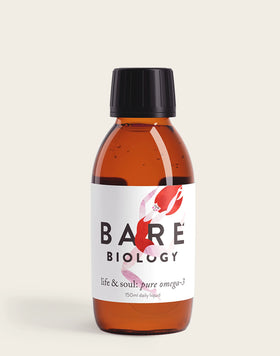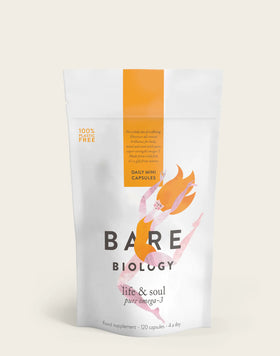Omega 3, 6 and 9. What’s the difference?
CONTENTS
Optimal Balance in Omega-3, 6, and 9 Fatty Acids for Your Health
How balanced is your life? Forget the daily juggle of work and life for a second, because we’re talking about your diet and, in particular, the good sources of omega-3, 6 and 9 it provides.
You may have heard of these essential fatty acids before and even seen omega-3-6-9 capsules for sale in the chemist. But is getting maximum amounts of all three what we should be aiming for? The more omega fats you can cram in during the course of the day the better, right?
Well not exactly. When it comes to your health it’s the ratio of all three working together that matters most. If it’s all starting to sound a bit of a numbers’ game, our guide to omega-3-6-9 fatty acids can help. It has all the answers you need to navigate this healthy trio.
The difference between omega-3, 6 and 9
Why do the different omega fats have different numbers and what’s the difference between them? It’s all down to the various omega-3-6-9 structures, as nutritionist Catherine Collins explains.
“All fats are named according to whether they have any unsaturated bonds in their chain,” she told us. “Saturated fats (for example processed meat, butter and cheese) contain no unsaturated bonds. Monounsaturated fats (like avocado, olives and nuts) have one that occurs at the ninth double bond – hence the name omega-9. Polyunsaturated fats (like oily fish and vegetable oils) are named according to where the first double bond occurs in the carbon backbone of the fat – which is either 3 or 6.”
Omega-3 and omega-6 have quite a lot in common. Both are essential fatty acids (EFAs), because they are necessary for human health, but our bodies cannot make them for themselves. Omega-9 fats are called “non-essential” because our bodies can produce them from any unsaturated fat we eat. The main Omega-9 in our diets is called oleic acid, found primarily in oils such as olive and peanut oil.
Related product
Omega-3, 6 and 9 benefits
The body uses omega-3, 6 and 9 in different ways:
Omega-3 and 6 are the only two fatty acids we can’t make for ourselves. They’re both used by the body for growth and repair. Omega-3 and 6 help build cell membranes and are precursors to many other substances in the body, such as our hormones. In balanced amounts, omega-3 and 6 complement each other perfectly. While omega-6 increases inflammation (very important when it comes to your immune system), helps your blood to clot and cells to proliferate, omega-3 does the opposite. They both work together to keep the body in check.
Omega-9 can be used by the body when omega-3 and 6 fatty acids aren’t readily available. If you have low levels of omega-3 and 6, the body will use omega-9 instead. It’s a bit like using hand cream on your face because you’ve run out of your anti-ageing serum. It will do the job, but not quite as well. However, foods rich in the omega-9 fat oleic acid such as olive oil are recommended as part of a heart-healthy Mediterranean diet.
Five great reasons to take omega-3
There are many different types of fatty acids that belong to the omega-3 family, but EPA (eicosapentaenoic acid), DHA (docosahexaenoic acid) and ALA (alpha-linolenic acid) are the three types you hear about most often, because they’re the most useful to our bodies.
Blood Pressure
Heart Health
Brain Health
Eye Health
Pregnancy Support
Omega-3, 6 and 9 sources
There was once a time when omega-3 could be found in plentiful amounts in many of the foods we ate - in the eggs of free-roaming chickens and in the meat and dairy products we got from our grass-fed cattle. The advent of industrialised agriculture changed all this. Our chickens, cows and sheep are now fed with grain rather than their natural diets and, as a result, this essential fatty acid has quietly slipped out of our daily diets.
The main source of omega-3 these days is oily fish - great if you love tucking into wild salmon and fresh sardines each night, but not so great if the only fish you like is rectangle-shaped and covered in breadcrumbs.
Nuts, flax, avocado and chia do contain small amounts of a precursor to omega-3 called ALA. This can be converted by the body into EPA and DHA (the beneficial components of omega-3) but not very efficiently. Less than 2% of ALA is converted to EPA by the liver and less than 0.5% of ALA is converted to DHA.
Omega-6, on the other hand, is rather more prevalent. It’s found in vegetable oils and because this kind of fat is cheap and has a long shelf life, it’s in virtually all processed foods, from crisps and biscuits to healthier sounding options like granola and hummus.
There are various different kinds of omega-9. Oleic acid is a monounsaturated fat found in olive oil, poultry fat and lard. Erucic acid is a monounsaturated fat that is found in rapeseed, canola oil and mustard oil, while nervonic acid is a monounsaturated fat that is found in salmon, nuts (especially macadamias) and seeds.


To get 700mg of omega-3 per day, an amount that’s somewhere in the middle of the average suggested range for good health, you’d have to eat one serving of salmon every day.


Omega-3, 6 and 9 rich foods
You won’t find omega-3, 6 and 9 together in one source in nature, but you could easily cook some deliciously healthy omega-3-6-9 rich meals. A good example would be salmon cooked in olive oil, on a salad that’s sprinkled with nuts and seeds.
Omega-3 vs 6 and 9 - which is better?
They’re all important, but you need them all in balanced amounts. Omega-6 fats may be essential, but we already get lots of them in our diet - so many in fact, that most people in the West should aim to reduce their omega-6 intake, not increase it. Sadly though, our modern diets contain few omega-3 sources as we’ve mentioned before.
Omega-9 is important too, but because the body can make omega-9 itself out of the unsaturated fats we eat, there’s no real need to try to eat more of them at all. While omega-9 has been seen to lower cholesterol, you can have too much of a good thing. Too much omega-9 will eventually crowd out the omega-3 in your diet, just as much as omega-6 does.
Can you take too much omega-3, 6 and 9?
While we all get more omega-6 than we need and we don’t need omega-9 at all as our body can make it, most of us find it hard to get enough omega-3 in our diets to meet daily recommended amounts. For general good health, leading health agencies such as the World Health Organisation (WHO) suggest that the minimum amount of combined EPA and DHA healthy adults should be having per day is 250-500mg.
To get 500mg of omega-3 per day you’d have to eat one serving of salmon every day - and most of us aren’t eating anywhere near that much. Even if you do manage to eat a serving of fish every day, there’s also the worry about the amount of environmental toxins this could expose you to, such as mercury and other heavy metals.
How much omega-3-6-9 should I take?
When you see omega-3-6-9 supplements, they normally come in a ratio of 2:1:1 for omega-3-6-9 and that’s the ratios we should all be aiming for in our diets. Here in the West though, the omega-6 to 3 ratio can be as high as 15:1! Clearly, we should be trying to up the amounts of omega-3 we eat to counteract all the omega-6 in our diets.
Taking a good quality fish oil supplement such as Bare Biology’s Life & Soul can help us address this imbalance. A teaspoon of Life & Soul gives you 3,500mg of omega-3 in total, including a whopping 2,000mg of EPA and 1,000mg DHA. With just a hint of Sicilian lemon it’s a tasty way to counteract all that omega-6, plus it’s been given a 5-star rating from International Fish Oil Standards (IFOS) so you know it’s free from contaminants.
What is the problem with having too much omega-6?
The parent fatty acid of the omega-6 series is called linoleic acid (LA), which is predominantly found in vegetable oil. This is then synthesised into the long-chain omega-6 fatty acid, arachidonic acid (AA). Too much AA inhibits the production of the omega-3 long-chain fatty acids (EPA and DHA).
According to Jonathan Tammam, a dietician and research scientist in the department of physiology, anatomy and genetics at the University of Oxford, omega-6 per se isn’t bad for us: “The fatty acid arachidonic acid (AA) has an important function in brain chemistry. The problem is the amount and the proportion in comparison with our omega-3 intake.”
However, according to Dr Loren Cordain, ratios are unimportant. It is the “absolute amount” of both omega-6 and omega-3 fatty acids that determine their counts in our bodies.
“The body requires threshold amounts of both fatty acids to operate our metabolic machinery. Once threshold (absolute) amounts for both omega-6 and omega-3 are achieved, then the concept of ratios of one fatty acid to another become meaningful,” says Dr Cordain. “The typical Western diet is overloaded with omega-6 fatty acids at the expense of omega-3 fatty acids.”
In layman’s terms this means too much of anything is a bad thing. It is only in the context of the standard Western diet that the ratio of omega-3 to 6 matters. That’s why it’s not enough to just increase your levels of omega-3. You need to reduce your intake of omega-6 fats as well.


So should I take omega-3-6-9 supplements?
You’ll find omega-3-6-9 tablets in almost every health food shop, but are they really better than taking omega-3 alone?
The general consensus is that a combined supplement provides no additional benefit and that there are advantages in just taking a good omega-3 supplement instead.
Omega-6 is essential but if you live in the West, chances are you’re already eating too many of them. Omega-9 fatty acids are also easily obtained in the diet plus your body can make just what it needs already, so no need for a supplement here, either. It’s important to remember that omega-3-6-9 exist in a ratio to one another. There’s a cap on the total amount that the body can use, so they end up competing for space.
You need all three, but because of our typical diets, it’s best to maximise omega-3, minimise omega-6 and stick to the healthiest sources of omega-9 you can find, such as olive oil.

